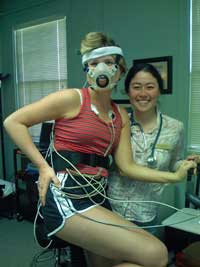 The Consult
The Consult
In Part I of the Dan Moricoli’s three part series on Dr. Klimas’s Heart Rate Based Activity Management Program on ME-CFSCommunity Center.com, we followed Brenda as she did a VO2 max exercise test on a bicycle at Dr. Klimas’s CFS Clinic. In the second video Dan video’s Brenda as she consults with Connie Sol, the exercise physiologist at Dr. Klimas’s Clinic, about her test results.
You exercise – you have no idea what you’re doing’ …and then you crash. That kind of approach is counterproductive and what shouldn’t be done.
Dr. Connie Sol, exercise physiologist for Dr. Klimas
In the video Connie points out to Brenda that she was able to engage in aerobic exercise for 2:40 before she hit her anerobic threshold and that she hit it at a heart rate of 104 beats per minute. It took her almost another 3 minutes (at 5 minutes and 20 secs) before she hit her VO2 max – meaning that she spent most of her exercise test drawing on stores of anaerobic energy – precisely what the activity management program will avoid. These figures would form the basis not just for Brenda’s exercise management program but for helping her keep her daytime activities at the appropriate level during the day.
The VO2 max machine ‘measures very accurately at the point at which it becomes unsafe to continue (exercise). Dr . Nancy. Klimas
The Key Measure – Perhaps the key activity management tool, however, is something called ‘resting heart rate’, which is measured after you get up in the morning. Your resting heart rate is measured by obtaining a cheap heart rate monitor (@$30 – Amazon.com) getting up in the morning for a bit and then lying down and taking the reading (before taking any stimulants such as coffee).
Pushing through fatigue only leads to more fatigue…You can’t beat it – but you can go around it. Dr. Connie Sol
Doing this over 10 days or so and keeping a simple activity and symptom log should help you notice how changes in your morning resting heart rate are associated with your symptom and energy levels that day. If you engaged in too much activity/stress over the day or two before – it will probably result in an increased morning resting heart – and a more symptomatic day. Connie Soler stated that if your RHR rises as much as 8% above your baseline level then you need to cut back on your exercise/activities. If you ignore that warning, you’re going to crash.
(This means you can use a heart rate monitor to manage your activity levels without doing the VO2 max testing. The VO2 max test can pinpoint the point at which exercise/activity level becomes dangerous but there are ways for the less well off of us to get some an idea of the maximum heart rate we should achieve during exercise/activity without doing the expensive testing…. How to do that will be presented in the third video).
 Finding Your Maximum Level of Activity – Because Brenda’s heart rate when she hit her anerobic threshold was 104 Connie chose 100 beats per minute as the highest heart rate Brenda should ever attain. Since she hit her anerobic threshold at about 3 minutes that was the longest she should attempt to do aerobic exercise. Brenda exercise protocol, then, would involve her exercising at no more than 100 beats per minute for no more than 3 minutes at a time. (Brenda, by the way, thought she was much more fit than she actually was and she hit her anerobic threshold more quickly than she had expected.)
Finding Your Maximum Level of Activity – Because Brenda’s heart rate when she hit her anerobic threshold was 104 Connie chose 100 beats per minute as the highest heart rate Brenda should ever attain. Since she hit her anerobic threshold at about 3 minutes that was the longest she should attempt to do aerobic exercise. Brenda exercise protocol, then, would involve her exercising at no more than 100 beats per minute for no more than 3 minutes at a time. (Brenda, by the way, thought she was much more fit than she actually was and she hit her anerobic threshold more quickly than she had expected.)
Protocol – Brenda’s protocol was simple….do three blocks of exercise just twice a week for a total of 4 exercise periods over two weeks. Each block would consist of
- Three minutes of walking
- Three minutes of rest to slow her body down and during which she would do very slow core exercises*-
- Three minutes of walking…
- Three minutes of active rest
*First block – 5 situps done very slowly. Second block – 5 leg lifts done very slowly. Third block – 5 stretches.
If her resting heart rate remained stable over the first two weeks then she would do the protocol 3 x’s a week. If it was still stable after that she could add a block. Note that she’s never at this point, doing the protocol more than once every two days.
Not Just an Exercise Program – An Activity Management Program – In order for the program to be effective you have to learn how to manage your activity levels. After all, if you’re pushing yourself into your anaerobic threshold during other activities, then you’re going to crash and, as was noted earlier, once you’re in a crash state – doing any exercise at all is counterproductive. (Dan Moricoli, for instance, has gone for as long as week without doing his exercise program because he’s (knowingly) pushed himself too far with other activities.)
The success of this program is dependent on how well you listen to your body Dr. Connie Sol
The key element in this program, then, is finding a baseline level of healthy activity and then folding the exercise program into it. (Dr. Snell recently noted that some really severely affected people can push themselves into their anaerobic threshold just by sitting up. How the severely impaired patient utilizes this type of activity management program will show up in the third video.)
Because her anerobic threshold was reached so quickly Brenda was told not to spend more than 3 minutes at any type of physical activity. She should monitor her heart rate and after 3 minutes of physical activity she should rest.
A Slow Process – The results of the Klimas/Sol energy management program come slowly… which speaks to the fragility of the energy production process in ME. It would take three months, Connie said, before Brenda would begin to notice changes but if she stuck with it over 6 months and into a year she promised would see significant changes in her levels of well-being. Dr. Klimas suggested finding a friend to work with it. (Check out the ME/CFS Community Centers Exercise group.)
 If you engage in the activity management program you may feel better and, in some cases considerably better. Neither Dr. Klimas or Dr. Sol posit the program as a cure…the physiological impairments that have restricted the patient’s aerobic functioning in the first place are still intact – but by working inside of them, your endurance level, fitness and feelings of well-being can increase markedly as we’ll see in an interview coming up with two people who are in the program.
If you engage in the activity management program you may feel better and, in some cases considerably better. Neither Dr. Klimas or Dr. Sol posit the program as a cure…the physiological impairments that have restricted the patient’s aerobic functioning in the first place are still intact – but by working inside of them, your endurance level, fitness and feelings of well-being can increase markedly as we’ll see in an interview coming up with two people who are in the program.

